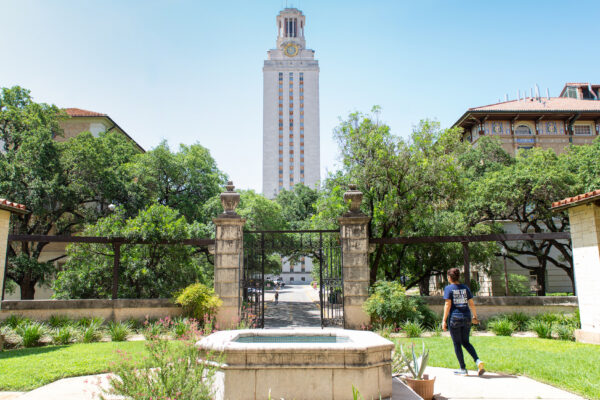AUSTIN, Texas — With more students than ever graduating on time, The University of Texas at Austin has been able to expand capacity, admitting its largest-ever incoming class.
The university has 9,060 first-time freshmen undergraduates, according to data collected on the 12th class day of this semester. The previous high for the entering first-year class was 8,960 in 2018.
Total university enrollment rose 3% over last year from 50,476 to 51,992, which is close to the all-time high of 52,261 set in 2002.
The increases, which followed record high application numbers, were made possible in large part by rising four- and six-year graduation rates. UT Austin once again set all-time highs in both categories. The four-year rate rose from 72.2% to 72.7%. The six-year rate rose from 87.6% to 87.7%.
Students and their families save money when students graduate on time. And moving students through the university more quickly frees up hundreds of additional seats a year for entering first-year students.
“By helping more students graduate on time, we are increasing access to UT,” said UT Austin President Jay Hartzell. “This is especially important now, because more outstanding students than ever are seeking the rigorous education, in-person learning and residential college experience that UT offers.”
The university is also serving more first-generation and historically underrepresented groups than ever, while continuing to serve some of its highest numbers of students eligible for Pell grants, which are available to low-income families.
Enrollment of first-generation undergraduate students rose from 9,122 to 9,387, 22.9% of all undergraduates.
Hispanic enrollment reached all-time highs. The percentage of Hispanic undergraduates jumped a full percentage point, from 26.1% to 27.1%, even as overall university enrollment increased significantly.
Last year, UT Austin reached the undergraduate enrollment threshold of 25% Hispanic to qualify as a Hispanic-Serving Institution (HSI). The university also received the prestigious Seal of Excelencia, granted to a small group of colleges and universities committed to accelerating Latino student success. This year’s enrollment gains further cement the university’s trajectory as one of the country’s largest and most academically prestigious HSIs.
The number of Black undergraduates increased from 2,193 to 2,219, with the number of Black students overall (graduate and undergraduate) increasing from 2,660 to 2,728. The percentage of Black undergraduates fell slightly to 5.4% from last year’s record high of 5.5%.
Overall, the university’s number and percentage of historically underrepresented students — who identify as Black, Hispanic, American Indian or Alaska Native, or Native Hawaiian or Other Pacific Islander — rose to their highest levels ever, representing 32.7% of the undergraduate population and 29.6% of the university as a whole.
At the undergraduate level alone, UT Austin will educate 13,366 historically underrepresented students in 2021, one of the largest totals of any state flagship university or member of the prestigious Association of American Universities.
“People all across the UT community have been working hard to recruit, attract, retain and support even more talented and diverse students, staff members and faculty members who can change the world,” said Hartzell. “I’m proud that our combined enrollment of historically underrepresented groups has reached record levels for the second year in a row.”
Numbers for international students also rose, from 4,173 (8.3% of all students) in 2020 to 4,725 (9.1% of all students) this year.
Graduation rates at UT have shown consistent improvement since 2011, when the university set a goal of increasing the four-year graduation rate from 52% to 70%. Beginning in 2012-2013, the university implemented campus-wide student success programs and analyzed student data to provide proactive support for students to help them define and stick with a path toward graduation. The programs offer peer mentoring, academic support and scholarship access to help more incoming students succeed in college.
* Preliminary as of 12th class day | ** Black includes both “Black or African American alone” and “Black or African American Multiracial (excluding Hispanic) |
|||||||||||||||||||||||||||||||||||||||||||||||||||||||||||
Notable fall enrollment figures (all comparisons are year over year, from fall 2020 to fall 2021):
- The size of the entering freshman class increased from 8,459 to 9,060, up 7.1%.
- The overall percentage of Hispanic students rose from 23.4% to 24.2%, and the percentage of Hispanic undergraduates rose from 26.1% to 27.1%, record highs.
- The overall number of Black students (both undergraduate and graduate) rose from 2,660 to 2,728 while the percentage fell slightly from 5.3% to 5.2%,
- The percentage of white undergraduates dropped from 37.3% to 35.1%.
- The percentage of Asian undergraduates rose from 23.2% to 23.8%.
- Applications for undergraduate admission rose 15.4% to a record of 66,077.
- The first-year retention rate fell slightly from last year’s record high of 96.7% to 96.4%.
- The number of first-generation college students increased from 9,122 to 9,387, while their percentage rose slightly from 22.8% to 22.9% of undergraduates.
- The four-year graduation rate for Pell-eligible students rose from 63.9% to a new high of 66.1%, further closing the gap with the graduation rate of non-Pell eligible students, which is 74.6%.
All 2021 figures in this release are as of the 12th class day and therefore preliminary. Some figures, such as graduation rates, may change slightly as further information on student status is finalized for federal and state reporting; final figures will be released in the statistical handbook, the definitive source of annual data on the university.




